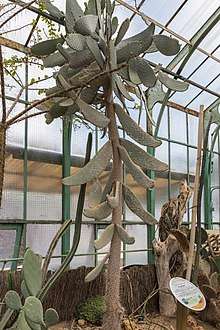Consolea moniliformis
Consolea moniliformis is a species of cactus that's native to Cuba, Dominican Republic, Haiti, Puerto Rico (on Mona Island, Culebra and Desecheo).[1]
| Consolea moniliformis | |
|---|---|
 | |
| Scientific classification | |
| Kingdom: | Plantae |
| Clade: | Tracheophytes |
| Clade: | Angiosperms |
| Clade: | Eudicots |
| Order: | Caryophyllales |
| Family: | Cactaceae |
| Genus: | Consolea |
| Species: | C. moniliformis |
| Binomial name | |
| Consolea moniliformis (L.) A.Berger, 1926 | |
| Synonyms | |
|
List
| |
Ecology and habitat
Consolea moniliformis can be found at elevations from sea level to about 50 metres. In Cuba, it occurs in dry littoral forest. It also occurs on limestone. In Puerto Rico, it occurs in open dry forests and is sparsely distributed. In Santiago de Cuba it is cultivated in gardens. It occurs abundantly. Its population is male-biased throughout the range. It is unknown whether there is seedling recruitment in the wild.
Description

It is a tree-like cactus species to 4(-7) m hight, freely branching in the crowns. In this species, as in a few other opuntias, the fruits are quite proliferous, often in long chains of 2-5 (or more) individuals or forming compound clusters. They hang on for a number of years and usually remaining green. They are, however, easily detached, and, when falling to the ground, they readily take root and start new colonies.[2]
Common names in various languages
Common names include:[3]
- English: Necklacelike pricklypear
- French: Opuntia patte-de-tortue, Patte de tortue, Patte tortue, Raquette espagnole (Haiti)
- Spanish: Alpargata (Dominican Republic), Tuna (Puerto Rico)
- Haitian Creole: Pat tôti, Rakèt panyôl
References
- Consolea moniliformis Consulted 15 April 2020.
- Consolea moniliformis Consulted 15 April 2020.
- Grandtner, Miroslav M. (2005). Elsevier's Dictionary of Trees - North America. Amsterdam: Elsevier. p. 594.
Bibliography
- Forest & Kim Starr. Plants of Hawaii.CS1 maint: ref=harv (link)
- Grandtner, M. M. (2005). Elsevier's Dictionary of Trees. Amsterdam: Elsevier. ISBN 0-444-51784-7.CS1 maint: ref=harv (link)
- Liogier, Alain H. (1994). Descriptive Flora of Puerto Rico and Adjacent Islands: Spermatophyta. Cyrillaceae to Myrtaceae. Puerto rico: Editorial de la Universidad de Puerto Rico. ISBN 0-8477-2333-X.CS1 maint: ref=harv (link)
